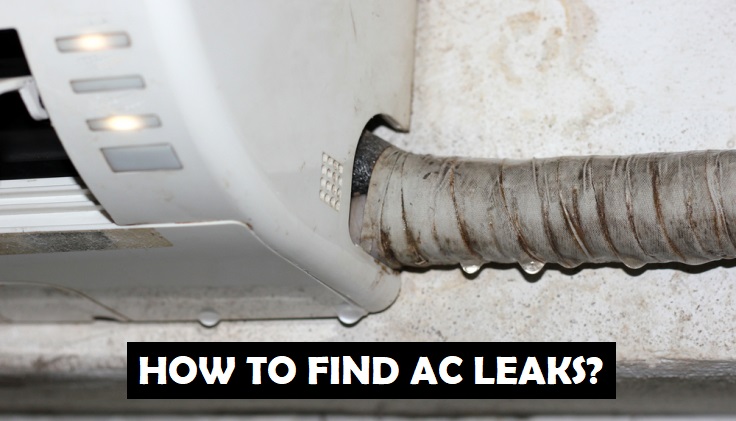Air conditioning is a wonderful invention that keeps our homes and offices comfortable during hot weather. However, like any complex system, air conditioners can develop problems over time. One common issue is AC leaks, which can lead to reduced cooling performance and higher energy bills. In this article, we will explore how to find AC leaks and address the issue promptly.

Signs of AC Leaks
Detecting AC leaks early is crucial to avoid further damage. There are several signs that indicate your air conditioner might be leaking refrigerant:
Weak Cooling
If you notice that your AC is not cooling your space as efficiently as before, there could be a refrigerant leak. Low refrigerant levels can hinder the cooling process, making your unit work harder without providing adequate cooling.
Frequent AC Cycling
AC units experiencing refrigerant leaks may cycle on and off more frequently. The system tries to compensate for the insufficient refrigerant by running more frequently, leading to increased wear and tear.
Ice Buildup on Coils
Icy buildup on the evaporator coils is a clear sign of an AC leak. When refrigerant levels are low, the coils may freeze, obstructing the proper flow of air.
Hissing or Bubbling Sounds
Unusual hissing or bubbling sounds coming from the AC unit may indicate refrigerant leaking. The hissing sound is often associated with refrigerant escaping through a small hole or crack.
Tools Needed for AC Leak Detection
Before attempting to find AC leaks, you’ll need the right tools for the job:
UV Leak Detection Kit
A UV leak detection kit includes UV dye that is added to the AC system. The dye circulates with the refrigerant and is visible under UV light, making it easier to spot leaks.
Electronic Leak Detector
An electronic leak detector is a handheld device that senses the presence of refrigerant gases in the air. It helps pinpoint the exact location of the leak.
Soap Bubble Solution
A simple soap bubble solution can also be used to detect AC leaks. When applied to suspected areas, bubbles will form if there is a leak.
Step-by-Step Guide to Finding AC Leaks
Finding AC leaks involves a systematic approach:
1. Turn off the AC Unit
For safety purposes, turn off the AC unit before starting the leak detection process.
2. Inspect Visible Components
Visually inspect the AC system for any signs of oil residue or corrosion, which can indicate a leak.
3. Use a UV Leak Detection Kit
Add UV dye to the AC system and let it circulate for a while. Then, use a UV light to check for any fluorescent spots, which indicate leaks.
4. Utilize an Electronic Leak Detector
Run the electronic leak detector along the AC system’s components to identify leaks through the emitted sounds or visual indicators on the device.
5. Apply Soap Bubble Solution
Apply the soap bubble solution to connections and joints in the AC system. If bubbles appear, there is likely a leak.
6. Check the Condensate Drain Line
A clogged condensate drain line can also cause leaks. Ensure the drain line is clear and functioning correctly.
Common Causes of AC Leaks
Understanding the underlying causes of AC leaks can help prevent them in the future:
Wear and Tear on Components
Over time, wear and tear can cause cracks or holes in the AC system, leading to leaks.
Corrosion and Rust
Corrosion and rust weaken the AC system’s components, making them more susceptible to leaks.
Poor Installation
Improper installation can result in loose connections and refrigerant leaks.
Clogged Drain Line
A clogged drain line can cause water buildup, leading to leaks and potential water damage.
How to Prevent AC Leaks
Prevention is always better than cure. Here are some preventive measures to avoid AC leaks:
Regular Maintenance
Schedule regular maintenance with a professional HVAC technician to check for leaks and ensure optimal system performance.
Changing Air Filters
Regularly replace air filters to prevent debris buildup and reduce strain on the AC system.
Cleaning the Condenser Coils
Keep the condenser coils clean to maintain efficient heat transfer and prevent leaks.
Ensuring Proper Installation
Ensure your AC system is installed correctly by hiring a reputable HVAC installation service.
DIY vs. Professional AC Leak Detection
While some may attempt DIY leak detection, it’s essential to weigh the pros and cons:
Pros of DIY
- Cost savings on professional services
- Immediate action if a leak is detected
Cons of DIY
- Risk of misdiagnosis or incomplete detection
- Potential safety hazards when dealing with refrigerant
Benefits of Hiring a Professional
- Expertise and experience in AC leak detection
- Proper handling of refrigerant and adherence to safety protocols
Repairing AC Leaks
Repairing AC leaks should be done promptly to avoid further damage:
Sealing Small Leaks
Small leaks can be sealed with appropriate refrigerant sealants.
Replacing Damaged Components
For significant leaks or damaged components, replacement may be necessary.
Recharging Refrigerant
Once the leaks are repaired, the AC system needs to be recharged with the correct amount of refrigerant.
Detecting and addressing AC leaks early is crucial to maintain the efficiency and longevity of your air conditioning system. Regular maintenance and professional assistance can help you prevent and promptly resolve any leaks that may occur.




